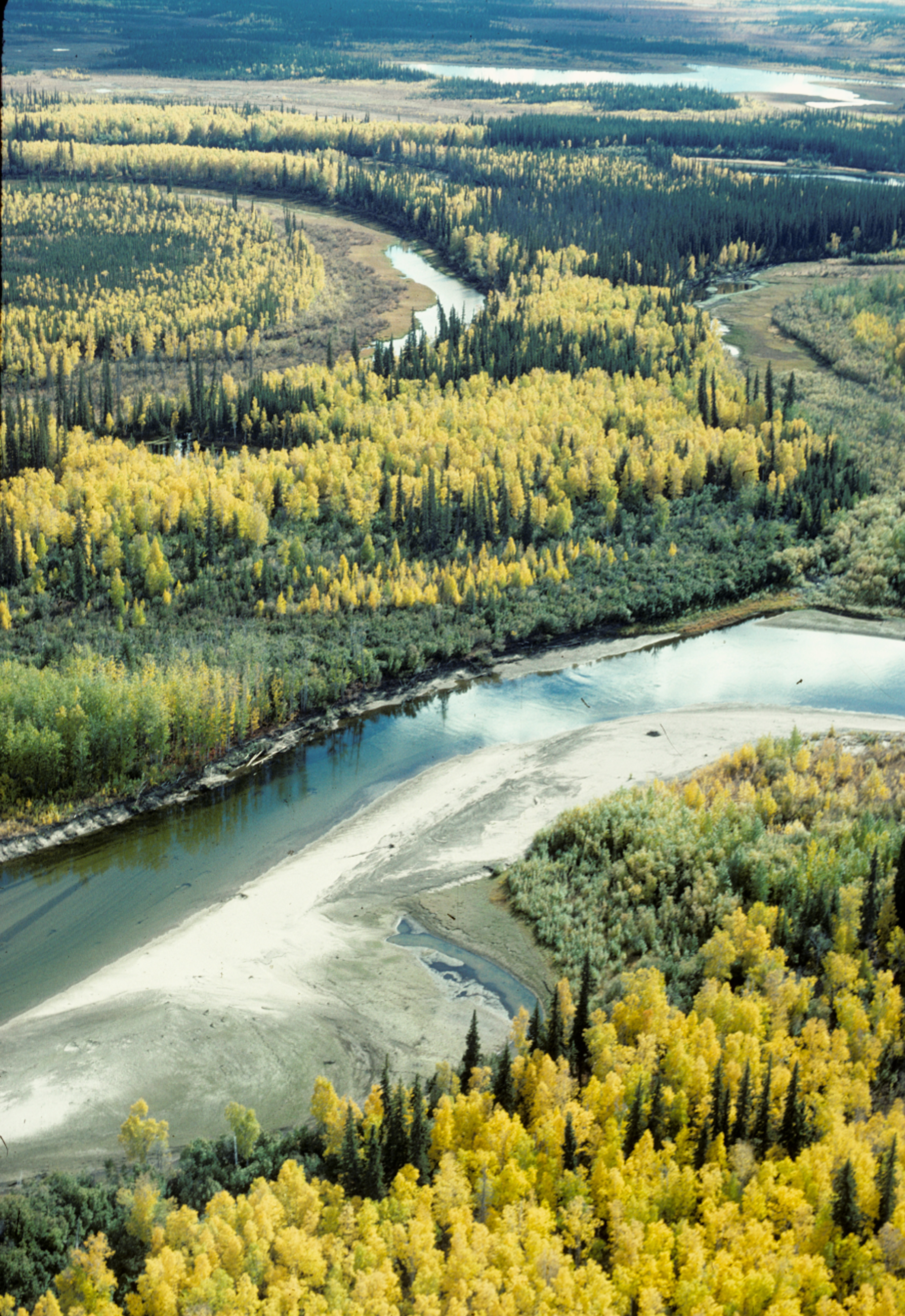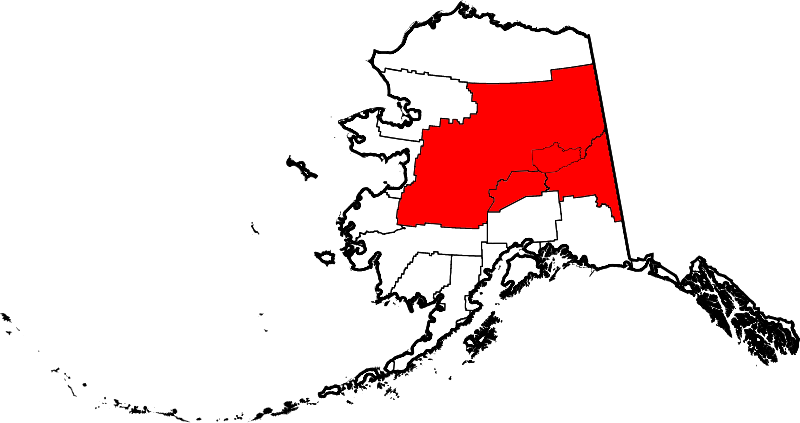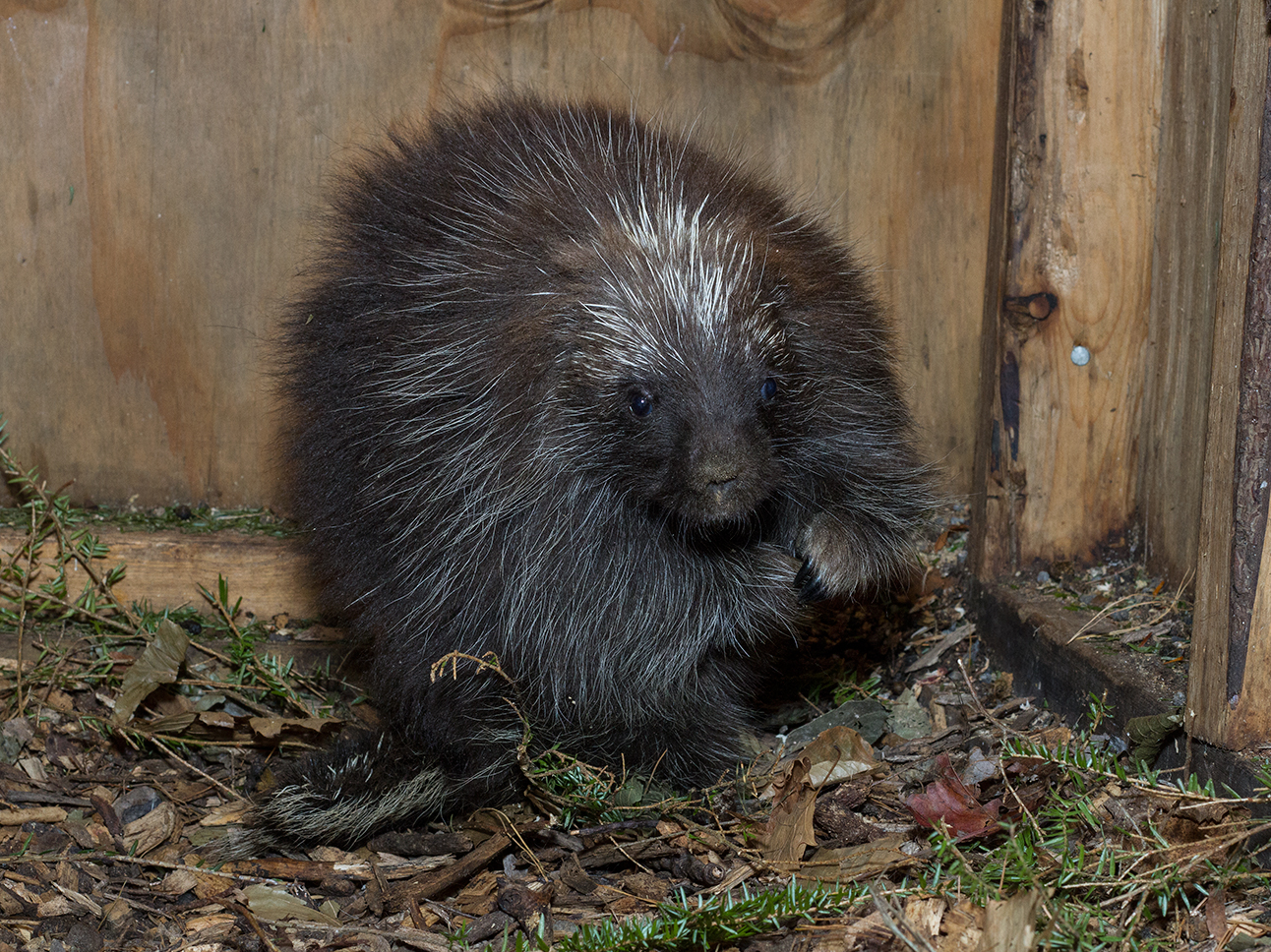|
Yukon Flats National Wildlife Refuge
The Yukon Flats National Wildlife Refuge is a protected wetland area in the U.S. state of Alaska. It encompasses most of the Yukon Flats, a vast wetland area centered on the confluence of the Yukon River, Porcupine River, and Chandalar River. The area is a major waterfowl breeding ground, and after a proposal to flood the Yukon Flats via a dam on the Yukon River was turned down, the Yukon Flats were deemed worthy of protection. On 1 December 1978, US President Jimmy Carter designated the Yukon Flats as a National Monument on the basis of the Antiquities Act of 1906. In the course of the Alaska National Interest Lands Conservation Act of December 2, 1980, the area boundaries were changed after political criticism and the status was downgraded to that of a wildlife refuge. It is the third-largest National Wildlife Refuge in the United States, although it is less than one-half the size of either of the two largest, the Arctic National Wildlife Refuge, or the Yukon Delta National ... [...More Info...] [...Related Items...] OR: [Wikipedia] [Google] [Baidu] |
Interior Alaska
Interior Alaska is the central region of Alaska's territory, roughly bounded by the Alaska Range to the south and the Brooks Range to the north. It is largely wilderness. Mountains include Denali in the Alaska Range, the Wrangell Mountains, and the Ray Mountains. The native people of the interior are Alaskan Athabaskans. The largest city in the interior is Fairbanks, Alaska's second-largest city, in the Tanana Valley. Other towns include North Pole, just southeast of Fairbanks, Eagle, Tok, Glennallen, Delta Junction, Nenana, Anderson, Healy and Cantwell. The interior region has an estimated population of 113,154. __TOC__ Climate Interior Alaska experiences extreme seasonal temperature variability. Winter temperatures in Fairbanks average −12 ° F (−24 ° C) and summer temperatures average +62 °F (+17 °C). Temperatures there have been recorded as low as −65 °F (−54 °C) in mid-winter, and as high as +99 °F (+37 °C) in ... [...More Info...] [...Related Items...] OR: [Wikipedia] [Google] [Baidu] |
Arctic National Wildlife Refuge
The Arctic National Wildlife Refuge (ANWR or Arctic Refuge) is a national wildlife refuge in northeastern Alaska, United States on traditional Gwich'in lands. It consists of in the Alaska North Slope region. It is the largest national wildlife refuge in the country, slightly larger than the Yukon Delta National Wildlife Refuge. The refuge is administered from offices in Fairbanks. ANWR includes a large variety of species of plants and animals, such as polar bears, grizzly bears, black bears, moose, caribou, wolves, eagles, lynx, wolverine, marten, beaver and migratory birds, which rely on the refuge. Just across the border in Yukon, Canada, are two Canadian National Parks, Ivvavik and Vuntut. History The Arctic Refuge is part of the traditional homelands of many bands or tribes of the Gwichʼin people. For thousands of years, the Gwich'in have called the coastal plain of the Arctic Refuge “Iizhik Gwats’an Gwandaii Goodlit” (The Sacred Place Where Life Begins). The ... [...More Info...] [...Related Items...] OR: [Wikipedia] [Google] [Baidu] |
Red Fox
The red fox (''Vulpes vulpes'') is the largest of the true foxes and one of the most widely distributed members of the Order (biology), order Carnivora, being present across the entire Northern Hemisphere including most of North America, Europe and Asia, plus parts of North Africa. It is listed as least concern by the IUCN. Its range has increased alongside human expansion, having been Foxes in Australia, introduced to Australia, where it is considered harmful to native mammals and bird populations. Due to its presence in Australia, it is included on the list of the List of the world's 100 worst invasive species, "world's 100 worst invasive species". The red fox originated from smaller-sized ancestors from Eurasia during the Middle Villafranchian period, and colonised North America shortly after the Wisconsin glaciation. Among the true foxes, the red fox represents a more progressive form in the direction of Carnivore, carnivory. Apart from its large size, the red fox is disting ... [...More Info...] [...Related Items...] OR: [Wikipedia] [Google] [Baidu] |
Golden Eagle
The golden eagle (''Aquila chrysaetos'') is a bird of prey living in the Northern Hemisphere. It is the most widely distributed species of eagle. Like all eagles, it belongs to the family Accipitridae. They are one of the best-known bird of prey, birds of prey in the Northern Hemisphere. These birds are dark brown, with lighter golden-brown plumage on their napes. Immature eagles of this species typically have white on the tail and often have white markings on the wings. Golden eagles use their agility and speed combined with powerful feet and large, sharp talons to hunt a variety of prey, mainly hares, rabbits, and marmots and other ground squirrels. Golden eagles maintain home ranges or territories that may be as large as . They build large bird nest, nests in cliffs and other high places to which they may return for several breeding years. Most breeding activities take place in the spring; they are monogamous and may remain together for several years or possibly for life. Fe ... [...More Info...] [...Related Items...] OR: [Wikipedia] [Google] [Baidu] |
North American River Otter
The North American river otter (''Lontra canadensis''), also known as the northern river otter and river otter, is a semiaquatic mammal that endemism, only lives on the North American continent, along its waterways and coasts. An adult North American river otter can weigh between . The river otter is protected and insulated by a thick, water-repellent coat of fur. The North American river otter, a member of the subfamily Lutrinae in the weasel family (Mustelidae), is equally versatile in the water and on land. It establishes a burrow close to the water's edge in river, lake, swamp, coastal shoreline, tidal flat, or estuary ecosystems. The den typically has many tunnel openings, one of which generally allows the otter to enter and exit the body of water. Female North American river otters give birth in these burrows, producing litters of one to six young. North American river otters, like most predators, prey upon the most readily accessible species. Fish is a favored food among t ... [...More Info...] [...Related Items...] OR: [Wikipedia] [Google] [Baidu] |
Falcon
Falcons () are birds of prey in the genus ''Falco'', which includes about 40 species. Falcons are widely distributed on all continents of the world except Antarctica, though closely related raptors did occur there in the Eocene. Adult falcons have thin, tapered wings, which enable them to fly at high speed and change direction rapidly. Fledgling falcons, in their first year of flying, have longer flight feathers, which make their configuration more like that of a general-purpose bird such as a broad wing. This makes flying easier while learning the exceptional skills required to be effective hunters as adults. The falcons are the largest genus in the Falconinae subfamily of Falconidae, which itself also includes another subfamily comprising caracaras and a few other species. All these birds kill with their beaks, using a tomial "tooth" on the side of their beaks—unlike the hawks, eagles, and other birds of prey in the Accipitridae, which use their feet. The largest fal ... [...More Info...] [...Related Items...] OR: [Wikipedia] [Google] [Baidu] |
North American Porcupine
The North American porcupine (''Erethizon dorsatum''), also known as the Canadian porcupine, is a large quill-covered rodent in the New World porcupine family. It is the second largest rodent in North America, after the North American beaver (''Castor canadensis''). The porcupine is a caviomorph rodent whose ancestors crossed the Atlantic from Africa to Brazil 30 million years ago, and then migrated to North America during the Great American Interchange after the Isthmus of Panama rose 3 million years ago. Etymology The word "porcupine" comes from the middle or old French word , which means 'thorn pig'. Its roots derive from the Latin words or pig and meaning thorns. Other colloquial names for the animal include quill pig. It is also referred to as the Canadian porcupine or common porcupine. The porcupine's scientific name, ''Erethizon dorsatum'', can be loosely translated as "the animal with the irritating back". Native American terms for it include the Lakota name meaning q ... [...More Info...] [...Related Items...] OR: [Wikipedia] [Google] [Baidu] |
Northwestern Wolf
The northwestern wolf (''Canis lupus occidentalis''), also known as the Mackenzie Valley wolf, Alaskan timber wolf, or Canadian timber wolf, is a subspecies of gray wolf in western North America. Arguably the largest grey wolf subspecies in the world, it ranges from Alaska, the upper Mackenzie River Valley; southward throughout the western Canadian provinces, aside from prairie landscapes in its southern portions, as well as the Northwestern United States.Mech, L. David (1981), ''The wolf: The Ecology and Behaviour of an Endangered Species'', University of Minnesota Press, p. 352, Taxonomy This wolf is recognized as a subspecies of ''Canis lupus'' in the taxonomic authority ''Mammal Species of the World'' (2005). The subspecies was first written of by Scottish naturalist Sir John Richardson in 1829. He chose to give it the name ''occidentalis'' in reference to its geographic location rather than label it by its color, as it was too variable to warrant such.Richardson, J. (18 ... [...More Info...] [...Related Items...] OR: [Wikipedia] [Google] [Baidu] |
American Black Bear
The American black bear (''Ursus americanus''), also called simply a black bear or sometimes a baribal, is a medium-sized bear endemic to North America. It is the continent's smallest and most widely distributed bear species. American black bears are omnivores, with their diets varying greatly depending on season and location. They typically live in largely forested areas, but will leave forests in search of food, and are sometimes attracted to human communities due to the immediate availability of food. The International Union for Conservation of Nature (IUCN) lists the American black bear as a least-concern species, due to its widespread distribution and a large population estimated to be twice that of all other bear species combined. Along with the brown bear (''Ursus arctos''), it is one of only two modern bear species not considered by the IUCN to be globally threatened with extinction. Taxonomy and evolution Despite living in North America, American black bears are not ... [...More Info...] [...Related Items...] OR: [Wikipedia] [Google] [Baidu] |
Bald Eagle
The bald eagle (''Haliaeetus leucocephalus'') is a bird of prey found in North America. A sea eagle, it has two known subspecies and forms a species pair with the white-tailed eagle (''Haliaeetus albicilla''), which occupies the same niche as the bald eagle in the Palearctic. Its range includes most of Canada and Alaska, all of the contiguous United States, and northern Mexico. It is found near large bodies of open water with an abundant food supply and old-growth trees for nesting. The bald eagle is an opportunistic feeder which subsists mainly on fish, which it swoops down upon and snatches from the water with its talons. It builds the largest nest of any North American bird and the largest tree nests ever recorded for any animal species, up to deep, wide, and in weight. Sexual maturity is attained at the age of four to five years. Bald eagles are not actually bald; the name derives from an older meaning of the word, "white headed". The adult is mainly brown with a white ... [...More Info...] [...Related Items...] OR: [Wikipedia] [Google] [Baidu] |
Alaska Moose
The Alaska moose (''Alces alces gigas''), or Alaskan moose in Alaska, or giant moose and Yukon moose in Canada, is a subspecies of moose that ranges from Alaska to western Yukon. The Alaska moose is the largest subspecies of moose. Alaska moose inhabit boreal forests and mixed deciduous forests throughout most of Alaska and most of Western Yukon. Like all moose subspecies, the Alaska moose is usually solitary but sometimes will form small herds. Typically, they only come into contact with other moose for mating or competition for mates. The males and females select different foraging habitats leading to spatial segregation throughout much of the year. During mating season, in autumn and winter, male Alaska moose become very aggressive and prone to attacking when startled. Diet Alaska moose have a similar diet to other moose subspecies, consisting of terrestrial vegetation forbs and shoots from trees such as willow and birch. Alaska moose require a daily intake of 9770 kilocalori ... [...More Info...] [...Related Items...] OR: [Wikipedia] [Google] [Baidu] |



.jpg)






.jpg)
